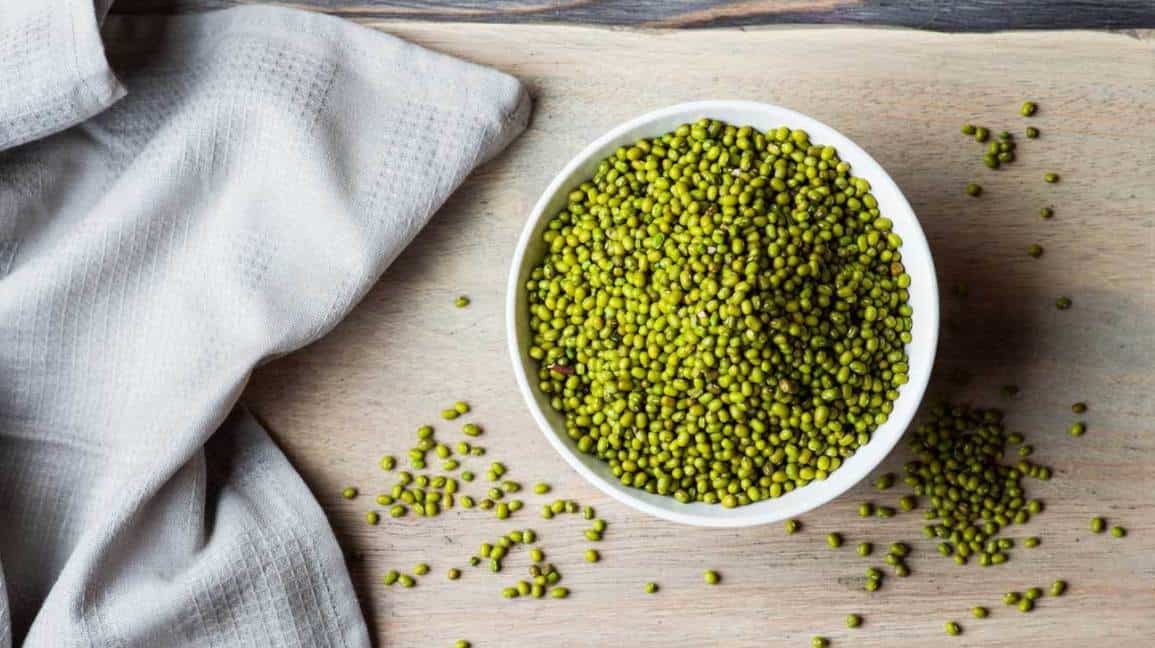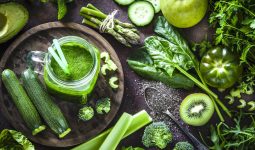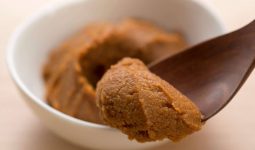Mung beans might sound new or unfamiliar to you but it is not new. It is has been around in India for thousands of years where it has been used as part of Ayurveda diets.
Ancient Indians considered mung beans as one of the most cherished foods and it has been a part of their traditional medicine recipes since 1,500 BC.
Mung beans are really getting a lot of attention among plant-based proteins. They are one of the healthiest sources of plant proteins and they contain many nutrients and have a lot of health benefits.
What Are Mung Beans?
Mung beans, Vigna radiate, are small green legumes. What most people call “bean sprouts” in Asian dishes are mung beans sprouts. They are very rich in phytochemicals, antioxidants, and fiber.
Lentils and mung beans are related but they are not the same. Mung beans are used in making many cuisines around the world, especially in Asia. It is also becoming popular in the US.
You can find mung beans in health shops in the form of canned soups, restaurant dishes, and protein powders. The whole uncooked beans can also be gotten from a healthy store.
Dried mung beans can be eaten raw, cooked, milled and ground into powder, or fermented.
Due to the high nutrient density of mung beans, they are added to sick people diet.
The Nutritional Profile of Mung Beans
202 grams (one cup) of mung beans contains about:
- 212 calories
- 54.5 milligrams of calcium (5% DV)
- 38.7 grams of carbohydrates
- 1.2 milligrams of niacin (6% DV)
- 14.2 grams of protein
- 5.1 micrograms of selenium (7% DV)
- 0.8 grams of fat
- 0.1 milligram of vitamin B6 (7% DV)
- 15.4 grams of fiber
- 0.1 milligrams of riboflavin (7% DV)
- 321 micrograms of folate (80% DV)
- 5.5 microgram of vitamin K (7% DV)
- 0.6 milligrams of manganese (30% DV)
- 0.8 milligrams of pantothenic acid (8% DV)
- 97 milligrams of magnesium (24% DV)
- 1.7 milligrams of zinc (11% DV)
- 0.33 milligrams of vitamin B1 (22% DV)
- 537 milligrams of potassium (15% DV)
- 200 milligrams of phosphorous (20% DV)
- 0.3 milligrams of copper (16% DV)
- 2.8 milligrams of iron (16% DV)
Also, vitamins A, C, and E are found in these beans. It also has choline. A cup of sprout mung beans eaten raw has 31 calories, 2 grams of fiber, and 3 grams of protein.
Uses of Mung Beans In Traditional Medicine

The domestication of mung beans was first seen in India where they grew as wild plants. Archaeological evidence proves that these beans were grown in the Harappan civilization in the Haryana and Punjab regions of India over 4,500 years ago.
Cultivated mung beans later spread to China and other parts of South East Asia. In Thailand also, mung beans have been cultivated and eaten for more than 2,200 years.
In the 9th or 10th century, mung beans were cultivated in Africa and they did well since they grow best in warm climates. Mung beans are grown in Southern Europe and in some parts of US since the 1830s.
Today, 15 to 20 million pounds of mung beans are consumed in the US. From historical records, we see that mung beans soup has been taken as form of health food in China for many centuries.
They valued these beans as a medicinal food because they discovered it could reduce dampness and coldness, it supports the spleen and stomach, it prevents nutritional deficiencies and also provides proteins.
Till date, Tradition Chinese Medicine (TCM) recommends mung beans in preventing diarrhea and improving digestion.
Health Benefits of Mung Beans
1. One of the easiest beans to digest
Many people experience bloating and gas from eating beans because of the digestion process of beans. However, mung beans don’t cause these problems as they are one of the easiest beans to digest.
Mung beans also help with detoxification and relieve digestive problems like constipation and IBS. The best way to use mung beans is to soak and sprout the dried beans overnight before cooking.
Cook the beans with spices like turmeric, ginger, coriander, and cumin to make them great pains and reduce digestive problems. Soaking and sprouting will also reduce the antinutrients in beans.
This makes the beans easier to digest and also release more of their nutrients. This also prevents uncomfortable flatulence.
2. Aids weight loss
The high levels of fiber in mung beans promote satiety and keep you feeling full for a long time thus preventing obesity. Foods high in proteins and fibers are the most filling foods and mung beans have both.
Regular consumption of legumes reduces your food intake and help boost weight loss.
3. Lowers blood pressure
Hypertension is a risk factor for cardiovascular disease and mung beans have shown potency in reducing systolic blood pressure.
Scientists have credited the anti-hypertensive properties of mung beans to the high concentration of protein fragments in these beans. These fragments are called peptides and they reduce the constriction of blood vessels thereby reducing systolic blood pressure.
4. Rich in antioxidants
Mung beans are rich in cancer-fighting antioxidants and thereby help in reducing cancer-related deaths. This is due to the high levels of amino acids, polyphenols, and oligosaccharides in these beans.
These compounds contribute to the antioxidant activity of mung beans. They have anti-tumor activities also and protect your cells and DNA from dangerous mutation.
Some phytochemicals in mung beans like isovitexin and vitexin are protective flavonoids with antioxidant activities. They scavenge free radicals and reduce oxidative stress and these two factors contribute to the development of cancer.
5. Helps with type II diabetes
Many studies have shown strong evidence that mung beans have powerful anti-diabetic property. This makes mung beans a good food for people managing type II diabetes.
Aside from reducing blood glucose levels, these beans also reduce plasma C-peptide, total cholesterol, glucagon, and triglycerides. It also increases insulin response and improve glucose tolerance.
6. Lowers cholesterol
Studies have shown that the consumption of legumes offers protection against cardiovascular disease and reduces the mortality caused by this disease.
Mung beans are highly effective in inhibiting the oxidation of LDL cholesterol (bad cholesterol). They also regulate the levels of cholesterol due to their rich content of antioxidants which are potent in scavenging free radicals.
The antioxidants in mung beans reduce inflammation and reverse damages done to the blood vessels. One of the biggest risks of cardiovascular disease is the oxidation of LDL cholesterol.
LDL cholesterol accumulates in the linings of the blood vessels (the endothelium) and blocks the flow of blood. This can lead to cardiac arrest or stroke.
The anti-inflammatory properties of mung beans prevent this and keep your arteries clear. This, in turn, improves circulation.
7. A rich source of protein
There is an impressive amount of mung beans in proteins. 20 to 24% of mung beans chemical structure is made up of amino acids (proteins).
The main storage proteins in this legume are albumin and globulin and they make up 85% of the total amino acids found in these beans.
A good way to reduce your risks of cardiovascular disease is to substitute unhealthy source of proteins with legumes like mung beans. It is a rich source of other amino acids like valine, isoleucine, and leucine.
Mung beans can be combining rightly with other plant sources like some vegetables and whole grains to make a complete protein. This makes this super food a good choice for vegetarians.
8. Boosts immunity
Due to the immune-boosting properties of mung beans, they help protect against viruses and infections.
They also contain a range of phytochemicals which have anti-inflammatory and antimicrobial properties. Right now, some compounds are extracted from mung beans and used to preserve certain foods and to reduce spoilage.
The antibacterial properties of mung beans help boost immunity by fighting against harmful bacteria, colds, viruses, irritations, rashes, and more.
It also helps promote a healthy flora of probiotics in your gut, and this, in turn, promotes immunity and the absorption of nutrients.
9. A rich source of vitamins and minerals
Mung beans are rich in folate, a very important nutrient needed for synthesis of DNA, cells, and tissues. It balances hormones and improves cognitive functions.
Folate promotes reproduction, hence pregnant women need folate. It prevents premature births, miscarriage, and neural tube defects.
People who are deficient in magnesium can increase their levels by consuming mung beans. This mineral helps with stress and pain and it is also needed for digestive health, heart health, the release of neurotransmitters, and repairing of muscles in physically active people.
10. Reduces the symptoms of PMS
One of the main causes of PMS is nutrient deficiency. Mung beans prevent this as it is dense in nutrients. It contains B vitamins and folate which helps in controlling the fluctuation of hormones during the reproductive cycle that can lead to PMS.
Magnesium, folate, and B vitamins lower pain and the severity of PMS symptoms. Some of the symptoms of PMS which mung beans relieve are muscle aches, fatigue, mood swings, headaches, and cramps.
So when next you see mung beans, don’t just pass by it. Get some for yourself and enjoy all the health benefits listed in this post.
Sources;








